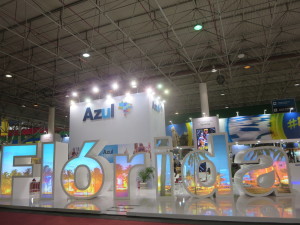The skies between the U.S. and Brazil have never been as crowded as, say, between the U.S. and the UK. But efforts to connect the two most populous countries in the Americas have nevertheless taken some unusual turns over the years — however short-lived. Hard not to remember, for example, Omar Fontana’s luxurious service between the two national capitals, Washington and Brasília, rather than between business centers, during the all too brief career of his late and lamented Transbrasil Airlines.
Now Brazil’s Azul Airlines has announced that it will commence daily service between Ft.
Lauderdale and the city of Campinas, in the interior of São Paulo State, as of December 1, between Orlando and Campinas as of December 15 and between New York and Campinas as of mid-2015. There is more to this than immediately meets the eye, and it is about as crazy as a fox is crazy.
Azul — meaning “blue” in Brazilian Portuguese as well as in Spanish — was created in 2008 by the same David Neeleman who had previously gotten JetBlue in the U.S. off the ground, and the strategy he has brought to bear in Brazil, where it happens he was born, is the same one he pioneered in the U.S. He used secondary airports to avoid airport congestion. He cut back on frills. He undercut the majors price-wise. He expanded the market.
Campinas, which few North Americans will even have heard of, is about an hour’s drive from the city of São Paulo metropolis and, until Azul started using it as a hub, it served primarily as a cargo port. FedEx. DHL. The Brazilian mail service.
Tickets for the new service between Campinas and the U.
S. went on sale on September 11 on the Brazilian site only, and, according to sales supervisor Luciano Matusiak, 55,000 tickets were sold in the first three days.
Azul tickets are not going to be given away.
They will merely be extremely competitive, but Mr. Matusiak promises many other significant goodies. Though Azul provides single class service only on its Brazilian domestic flights (back and forth between its 104 Brazilian destinations), the Airbus A330-200s in use internationally will be configured with 251 economy class and 27 executive class seats on its Florida flights and 240 economy class and 35 executive class seats on its New York flights.
Meal selection will be via the touch screen that will also serve up as many as 150 films, and breakfasts in particular, it is promised, will be quite spectacular. In the U.S. Azul will code share with United.
Azul’s target public is, needless to say, Brazilian. Not that southbound U.S. passengers will not be welcome.
American Airlines, which has come to be the lead player in the skies between the U.S. and Brazil, is hardly quaking in its boots. But it is nevertheless noteworthy that, at this year’s ABAV congress, still ongoing at the Anhembi Convention Center in São Paulo, Azul occupied a big bright installation right behind the main entrance and American, a smaller and much less brightly lighted one in the back. OK, American doesn’t have to prove anything to anyone. American isn’t the new kid on the block.
But, in a sign of changing times, American has announced that, as of December 2, one of its four daily frequencies between Miami and São Paulo will henceforth operate between Miami and Campinas and one of its two daily frequencies between New York and São Paulo will subsequently, several days a week, also operate in and out of Campinas.
ABAV, www.abav.com.br

